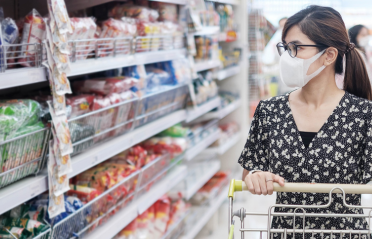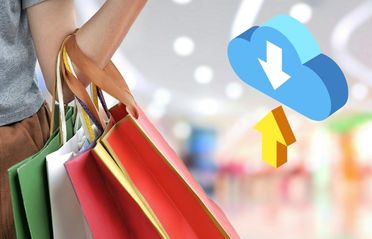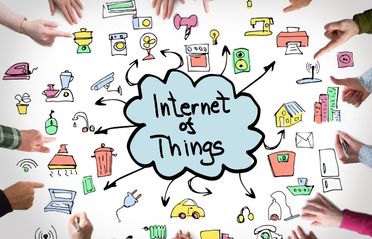As per the current scenario, retailers have access to a lot of in-store technologies that provide them with certain insights. These help in gathering information about the customers but have their limitations to render worthwhile judgments which can help retailers enhance the overall in-store experience
Below are a few examples of such technologies and their limitations.
1. In-Store Wi-Fi Service:
Wi-Fi services at retail help in keeping the customers “connected” while inside the store. It also facilitates the retailers to capture various key data points related to the customer location inside the store. For example: identifying the repeat customers entering the store, different competitor websites visited by the in-store customers, and the time spent by them in different sections of the store.
However, since this data is gathered only from the connected users, retailers often struggle to get incoming customers connected to the Wi-Fi due to poor onboarding methods, thus, leaving behind a chunk of users and limits the dataset for retailers to study. Moreover, with MAC Randomization evolving as well, solutions providing analytics without the need for the customer to connect to the Wi-Fi are also struggling with the accuracy & authenticity of their analysis. Thus, it becomes vital to have next-gen Wi-Fi Solutions so that customers connect more and have more insightful and relevant data.
2. In-Store Bluetooth Beacons:
Beacons send one-way signals to customers’ smart devices to communicate a message from a certain location. It is primarily used for tracking the in-store location of the customers or pushing ad/discount notifications onto their devices whenever they are in proximity of the beacons. When placed strategically across the space, they massively help to improve the overall in-store experience for customers.
However, besides its application requiring customers to keep the Bluetooth of their devices ON, which is an uncommon phenomenon, beacon signals are easily prone to get reflected or absorbed depending on the proximity of other beacons or surrounding materials. This can turn some parts of the store into blind spots. As a result, beacons can push irrelevant notifications. Moreover, Due to instabilities in Bluetooth signal strength as well as interference of cell phone antennas and beacon signals, some notifications come with a delay, which kills the relevance and the overall customer experience.
3. RFID:
Applications of RFID tags is as simple as applying price tags. RFID helps retailers maintain/track inventory throughout the retail supply chain, from the warehouse shelves to the sales floor, and prevents the loss of products as well. It can reduce wait times at the checkout where an entire shopping basket can be scanned at once with no items needed to be removed from the basket, unlike traditional barcode which requires light of sight for scanning. These benefits prove to be of great use and immense importance to both retailers and customers.
Sadly, apart from its capabilities remaining limited to the above-defined use-cases, RFID tags are easy to clone, especially if the chip has no authentication mechanism. Thus, for all customer-enhancing experiences RFID guarantees to deliver, security remains a top concern among retail industry professionals
4. Point of Sale:
The evergreen systems which are the core of any retail joint: POS systems, form the heart and soul of a retail store. It is a key tool for retailers to increase sales, keep an overview of stock, and provide high-quality customer service. They help log sales transactions, provide useful information regarding the customers, day to day and overall sales, store inventory, return goods information etc.
But such system information is limited to customers who have made a purchase, not giving any details regarding how many customers visited the store. Thus, making the retailer unaware of the effective conversion ratio of the store. Retailers mostly end up guessing about the number of customers who came in & just left, leading the level of coverage, accuracy, and precision to fall.
This presents a serious challenge for retailers to find the right technology.
Retailers have long trusted video solutions for in-store surveillance. However, with evolving retail, it has become a very well-known fact that the surveillance footage is not limited to traditional security applications. Incorporating artificial intelligence, in-store video analytics introduces a new, critical layer of delivering actionable insights, enabling strategies that enhance the customer shopping experience, stimulate shopper retention, and increase sales
First, it removes the various limitations present in the above-mentioned technologies:
- Tracks Everyone – It enables the retailers to track the locations of all the customers inside the store irrespective of their devices connected to Wi-Fi or having its Bluetooth turned ON.
- Tracks customer data irrespective of final purchase – It empowers retailers with substantial details regarding customer interactions (with different products) and various attributes of their real-time behavior (such as breaking queues) inside the store. None of this being dependent on customers making any final purchases.
- Tracks Customer Sentiments – There is a vast multitude of other things that can be made possible using video as a data source. Similar to a person’s eyesight, video empowers to observe and judge
With the current pandemic situation, the use of AI-powered video analytics has jumped multifold. It has come out to be one of the most efficient ways for retail stores to reassure their customers and employees that it is safe to work or shop. Therefore, many retail businesses have started to opt for video analytics solutions, to facilitate safer and more efficient shopping experiences for both buyers and employees. This hugely impacts the customer behavior for it enables them to eradicate their fear and gain lasting trust by making them feel safe. Some of the common use cases being opted by retailers are:
- Capacity Management: Keeping a track of the number of customers entering the store and help keep track of the real-time density inside the premise
- Social distancing: Monitor customers to ensure the required safe distance between them is maintained while moving inside the store or standing in a queue
- Face mask detection: identify and raise alarm if people in a store or the enclosed area (catchment area) are not wearing masks
- Monitoring people’s body temperature: Using a thermal camera to detect an anomaly in the body temperature of the people inside the store
Retailers are required to be highly equipped with their arsenal of technology solutions to leave no stone unturned while eyeing for having a meaningful interaction with customers and providing a great shopping experience. This required level of readiness is achieved when one is able to answer the following:
- Is the current Product display in aisles able to attract the appropriate number of customers?
- Is the store layout effective enough to lure customers and making the visit a productive one for them?
- Are the products easily visible and accessible to customers? Are there places which are being neglected by the customers?
- What is the optimal queue length, post which customers might break the queue?
- What are the spots in the retail store where marketing activity will be more efficient and turn highly successful?
Here, video analytics has great usage and application. It carries enormous potential to enable retailers to enhance the scope and profitability of their space. Video being a rich data source, helps retailers in their quest of gaining and retaining customers with the following types of analysis:
- People Counting: General people counting involves counting the total number of people coming and leaving the store. A more sophisticated analytics solution helps differentiate the staff from the visitors based on certain dress code parameters along with some other methods. This eventually helps to derive the staff to customer ratio and helps reallocate staff within the store to minimize the service time and improve the assisted shopping experience
- Sentiment Analysis: Facial expression analysis can change the paradigm of the customer shopping experience. It captures and understands customer sentiments while they are in the store. It also helps to quantify customer experience while interacting with various products in-store.
Dwell Time Analysis:
With such analysis in place, a store manager can visualize a particular in-store location that customers visit the most. Moreover, it can highlight the aisle and products which captured customers attention the most and with time identify what all customers need assistance
- Demographic Analysis: It helps differentiate the customers on the basis of gender or age and provide the right picture regarding the target segment the business is looking for. Correlating this with dwell time can reveal a more in-depth understanding of the customer.
- Queue Management: With time running and seconds rushing, customers become more fast-paced where they want to avoid the waiting time as much as possible. Queue management algorithms provide customer count in the queue along with the estimated wait time, helping optimize the total number of queues and reshuffle the customers between queues for a quicker billing experience.
- Inventory Tracking: Image analytics have proven to be lucrative to track in-store inventory and classify the products which are in high demand while also which are not, thus maintaining demand and supply more efficiently.
- Staff Engagement: Engagement can be measured by the amount of time the employees spend with the customers, which can have a huge impact on customer satisfaction levels. With customers increasingly looking forward to a more personalized experience in-store, video analytics can help store managers with a complete view of the staff engagement with in-store customers.
Video analytics involving artificial intelligence is a valuable addition to the transformative journey of brick-and-mortar retail. There is an amazing opportunity for retailers with HSC’s People insights AI to unveil the value of their video data, enabling them to deliver a transformative business outcome and answer the most difficult strategic questions. To know more about the product, please feel free to reach out to Hughes Systique. At HSC, we have been working towards building effective and highly useful solutions that can help retailers in their endeavor of understanding their precious customers

 Product Engineering Services Customized software development services for diverse domains
Product Engineering Services Customized software development services for diverse domains
 Quality Assurance End-to-end quality assurance and testing services
Quality Assurance End-to-end quality assurance and testing services
 Managed Services Achieve scalability, operational efficiency and business continuity
Managed Services Achieve scalability, operational efficiency and business continuity
 Technology Consulting & Architecture Leverage the extensive knowledge of our Domain Experts
Technology Consulting & Architecture Leverage the extensive knowledge of our Domain Experts

























